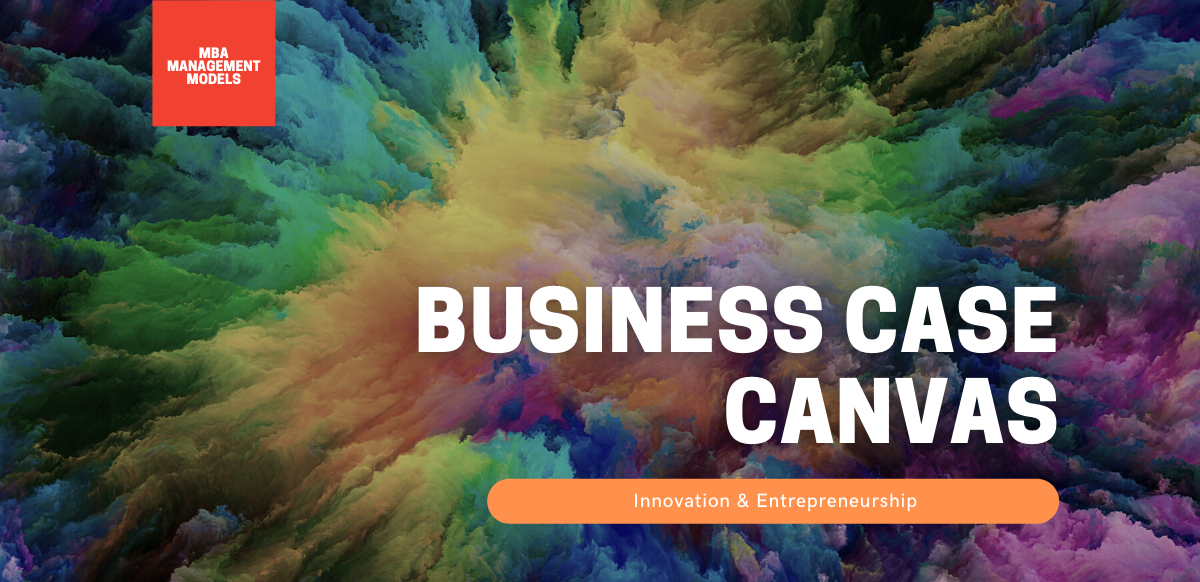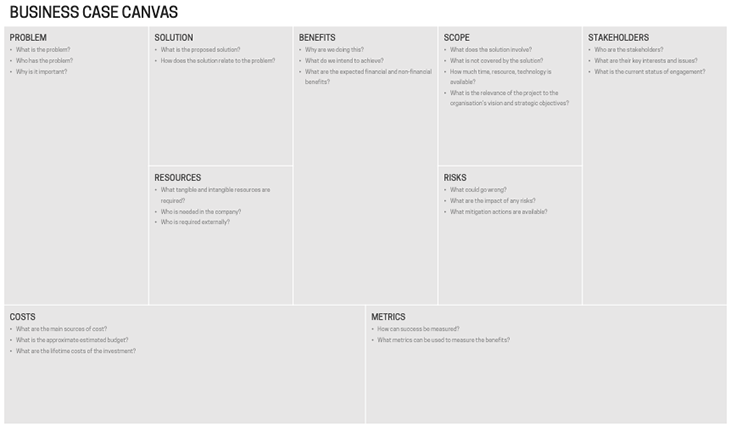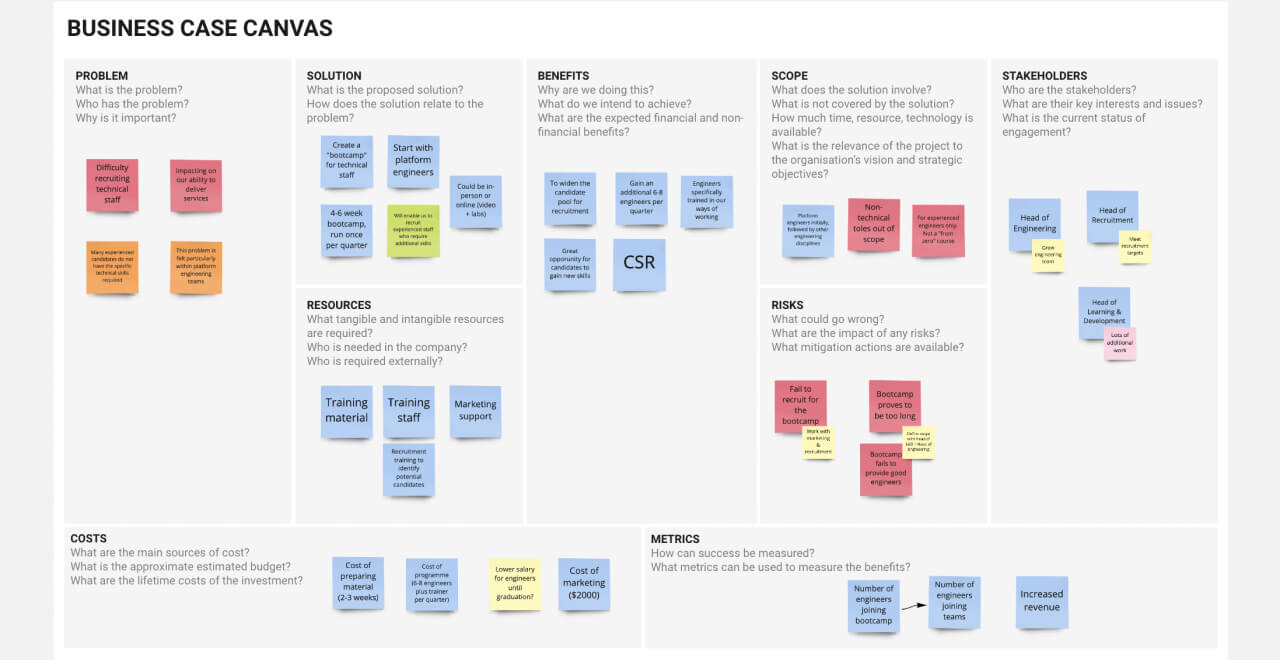Business Case Canvas
The Business Case Canvas, not to be confused with the Business Model Canvas, is a strategic management template that can be used to describe, visualise and assess the essential components of a business case in a simple and concise way.

What it is
The Business Case Canvas enables managers to visually and succinctly describe and analyse the critical components of a business case. Use of the Business Case Canvas ensures that all significant factors affecting the analysis, recommendation and subsequent investment decision are considered.
A business case is a recommendation to decision-makers to take a particular course of action. This recommendation is supported by an analysis of its benefits, costs and risks compared to the realistic alternatives. Finally, the business case should explain how the proposal can best be implemented.
The role of the Business Case Canvas is to articulate the rationale for the project in a concise and compelling way that can be used to establish the ground on which any debate will take place, so that a full business case, including an implementation plan, can be formulated.
The Business Case Canvas considers nine factors:
- Problem
- Solution
- Benefits
- Scope
- Stakeholders
- Resources
- Risks
- Costs
- Metrics
The Business Case Canvas allows these nine factors to be represented on a single page, as shown below:

A downloadable version of this Business Case Canvas document is available here.
Background
The first "canvas" model was the Business Model Canvas, initially specified in 2008 by Alexander Osterwalder. Since the release of Osterwalder's work, new canvases for specific tasks have appeared, of which the Business Case Canvas is one.
When to use it
- When building a case for action and/or investment in an organisation.
- As a tool to conduct competitor analysis.
How to use it
The Business Case Canvas can be created by an individual but also works well when created as a group, perhaps with a large-scale canvas and post-it notes or through the use of an online tool.
The following sections describe each of the nine factors captured within the canvas.
Problem
This is a brief description of the problem without considering any proposed solution. In this section, you should consider the people, processes and systems affected by the problem that has been identified and the priority of the proposed actions to resolve it.
Solution
This section provides space to outline the proposed solution. It is important to specify precisely how the solution relates to the problem identified in the previous section. Realistic alternative solutions should also be included here.
Benefits
The Benefits section is used to describe the purpose of the proposed course of action. This is the place to list the advantages of taking the proposed course of action, what it is intended to achieve and the financial and non-financial incentives to the business.
Scope
Use the scope section to define the boundaries of the solution. It is important here to clearly set out exactly what the solution involves as well as what is not covered by it. In this section, you should also describe the project's relevance to the organisation's vision and strategic objectives.
Stakeholders
List the primary and secondary stakeholders and their key interests in the project and any issues that may be solved, or result from, the implementation of the proposed solution. You should also use this section to assess the engagement levels of any stakeholders that are vital for a successful outcome.
Resources
What resources, tangible and intangible, are required for the implementation of the solution? Identify key personnel, both from within the company and externally and list any materials and equipment needed.
Costs
Use this section to identify the primary sources of cost, both for the implementation phases and for ongoing operations, maintenance and support. From this, you should aim to provide an approximate estimated budget.
Metrics
How will you know when a successful outcome has been achieved? What metrics can be used to measure the benefits upon completion and as the implementation of the proposed solution progresses?
If all key stakeholders have been involved in creating the canvas, a draft business case can be prepared based on the analysis carried out during its creation. Otherwise, the canvas should be presented to key stakeholders and other involved parties and subject matter experts for validation and input before the canvas is used to create the foundations of the business case.
Although it is a relatively simple and straightforward tool, it is vital to remember that the output will form the foundation of the full business case. Therefore, if insufficient effort is put into the creation of the Business Case Canvas, a weak business case will result.
Frequently asked questions (FAQs)
Is a Business Case Canvas an alternative to a business case?
The Business Case Canvas is designed to be a relatively lightweight and collaborative way to explore the feasibility of a course of action at an early stage. It is not intended to replace the need to create a full business case, which will be a more extensive document containing a robust justification for the recommendation and comprehensive comparative analyses of the risks, benefits and costs of the recommended course of action and the realistic alternatives, as well as a plan for implementation.
Do I need to update my Business Case Canvas?
As it is designed to be used at an early stage, there is a risk that the Business Case Canvas quickly becomes outdated, so an effort must be made to revisit and keep the canvas up to date as more information becomes available.
Further reading
Gambles, I. (2009) Making the Business Case: Proposals that Succeed for Projects that Work. London: Routledge.
Other useful resources
Downloadable Business Case Canvas template (PDF)

Some of the links to products provided in this article are affiliate links. This means that the supplier may pay the owner of this website a small amount of money for purchases made via the link. This will have absolutely no impact on the amount you pay.

